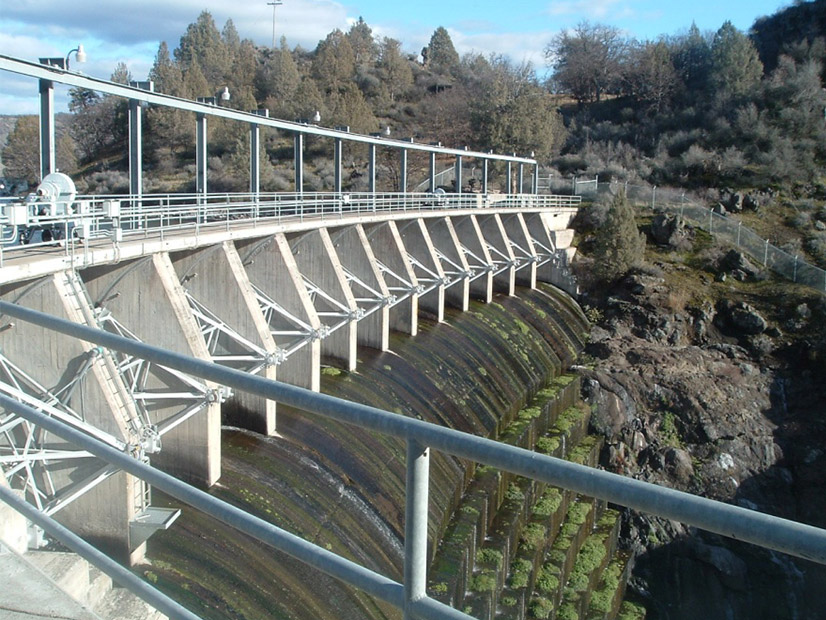Concluding a process that began more than 15 years ago, FERC last week approved transfer of the license for the 169-MW Klamath Hydroelectric Project from PacifiCorp to a group of parties that will decommission the series of eight dams that straddle the border between California and Oregon (P-2082-062).
The parties assuming the license include the states of California and Oregon and the Klamath River Renewal Corp. (KRRC), comprised of the Yurok and Karuk tribes and area farmers, ranchers, fisherman and environmental groups. All were party to the 2010 Klamath Hydroelectric Settlement Agreement (KHSA), which imposed a set of interim environmental measures and funding obligations on PacifiCorp ahead of the targeted 2020 decommissioning date of the project.
PacifiCorp decided to remove the four of the dams in 2004 following a long-running dispute over water rights and the health of salmon runs in the Klamath Basin. Before the project’s license was set to expire in 2006, the utility filed a proposal with FERC to relicense the three upper dams while decommissioning four lower dams considered too costly to modernize.
Since then, the project has operated under a series of annual interim licenses while approval of the broader license sat in limbo, largely due to PacifiCorp’s own efforts.
In 2016, a subset of the KHSA parties signed an amended agreement that would transfer the licenses for the four dams to the newly formed KRRC. Two years later, FERC approved PacifiCorp’s request to split the lower dams into a separate license, but it declined to rule on transferring the license until the KRRC could prove that it was capable of managing decommissioning.
“Transferring a project to a newly formed entity for the sole purpose of decommissioning and dam removal raises unique public interest concerns, specifically whether the transferee will have the legal, technical and financial capacity to safely remove project facilities and adequately restore project lands,” FERC said in the ruling.
FERC overcame those concerns in last week’s ruling because, under the new license agreement, KRRC’s decommissioning efforts would now be backed by California and Oregon.
“The applicants explain that under their current proposal, if transfer and surrender are both approved, decommissioning efforts would not rest solely with the Renewal Corporation. The States, as co-licensees, would provide additional experience related to large public infrastructure projects, including experience overseeing dam removal and operating projects subject to the Commission’s jurisdiction,” the commission wrote.
The commission also pointed out that PacifiCorp and the states had agreed to establish a $45 million contingency fund to cover cost overruns for a decommissioning process estimated to cost about $450 million.
The commissioners dismissed an argument by the County of Siskiyou, Calif., that the KRRC is a “shell corporation” only set up to shield PacifiCorp and the states of California and Oregon from liability associated with dam removal. The county also contended that that PacifiCorp should be required to remain on as a co-licensee due to its “knowledge, competence, and safety track record.”
FERC clarified that as co-licensee, the states will not be shielded from liability.
“With the States as co-licensees, we do not believe the public interest requires that PacifiCorp remain a co -licensee. Nor do we find that the Renewal Corporation is merely a ‘shell corporation.’ The Renewal Corporation is a California non-profit corporation in good standing, its articles of incorporation explicitly provide for implementation of the Amended Settlement Agreement, and its bylaws describe the day-to-day management responsibilities of the Renewal Corporation as licensee,” FERC wrote.
The commission also rejected the contention of some commenters who questioned whether the states are qualified to be co-licensees and have the experience or expertise to perform decommissioning. These commenters pointed to the February 2017 failure of the main spillway of the Oroville Dam, operated by the California Department of Water Resources, saying it was the result of “gross mismanagement” and that reconstruction suffered large cost overruns. (See Report: Regulatory Failure Caused Oroville Incident.)
“Actions by one California agency have no bearing on the issues here, in a case involving the states of California and Oregon, the Renewal Corporation, and a number of other parties,” FERC said. “In any case, following the Oroville dam incident, California DWR worked closely with commission staff, complied with commission directives, and bore the extensive costs associated with the required remediation.”
“The commenters do not demonstrate that the states lack the legal, technical, or financial resources to serve as co-licensees here,” the commission said.




